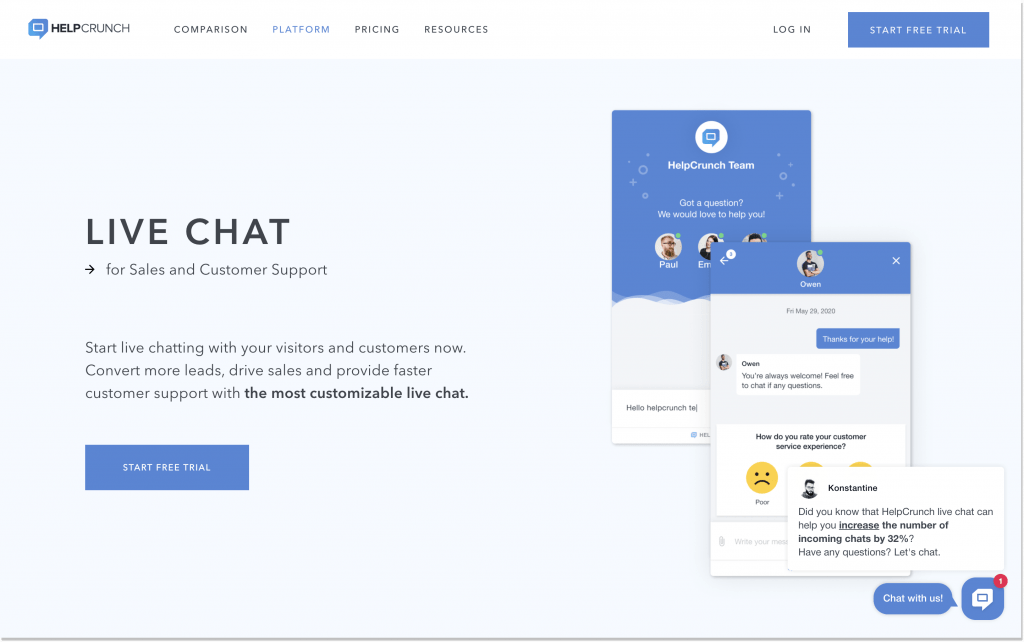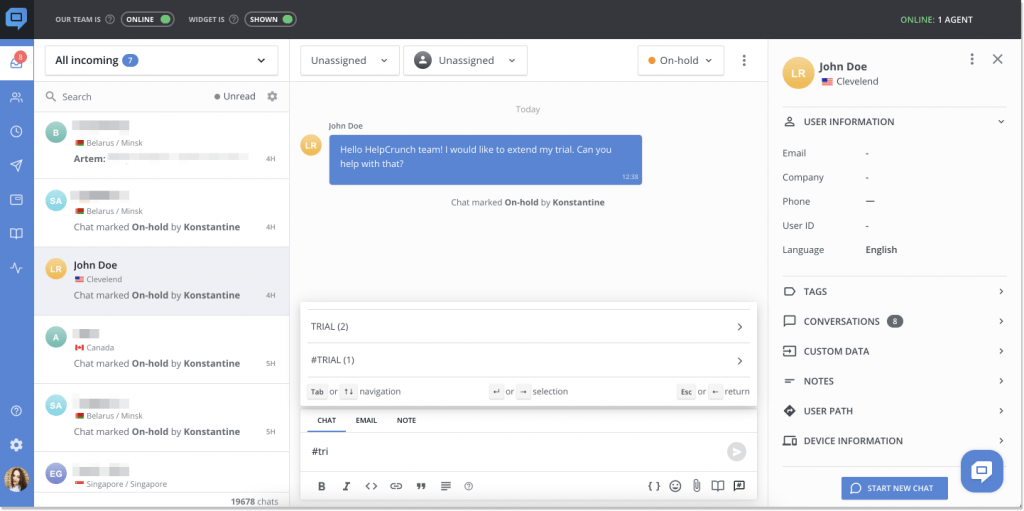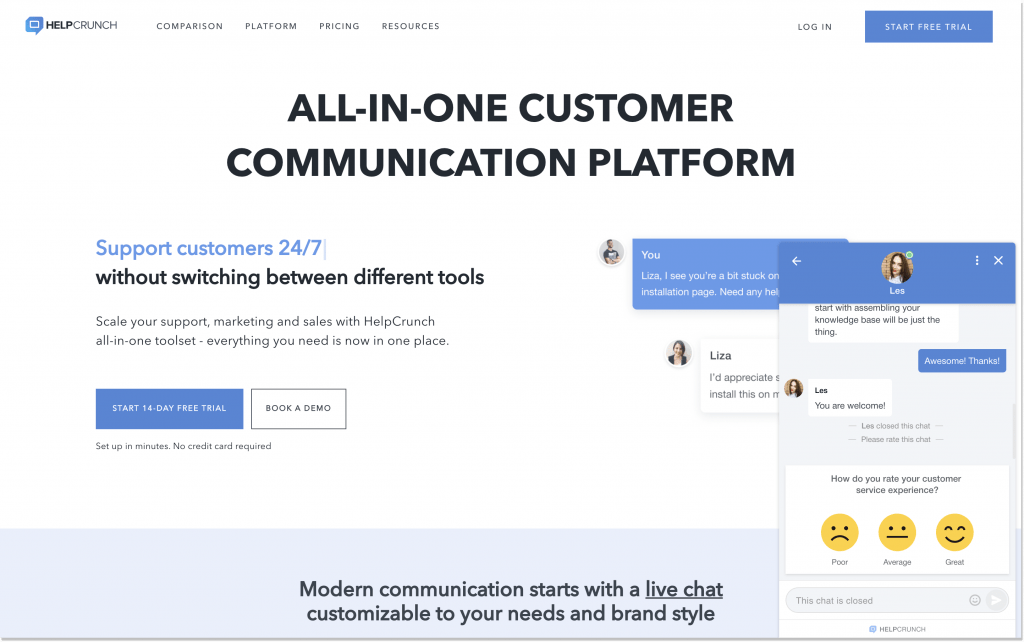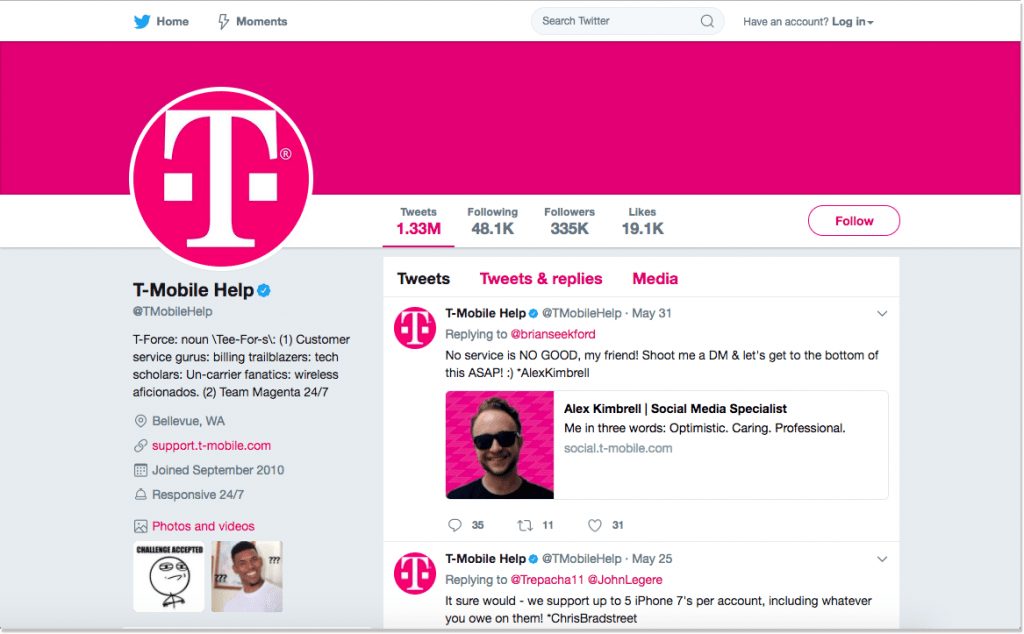10 Live Chat Best Practices You Can’t Go Without
There's no limit to perfection. And in customer service, too. We've compiled here 10 live chat best practices so that you can power up customer communications. Read on!
Written by Olesia Melnichenko

Customers love chatting. At least, live chat is their channel of choice when they do need to contact support. Chatting is fast, it allows to multi-task, and a chat conversation can be saved for later reference.
For businesses, having a live chat also brings heaps of benefits increasing customer satisfaction and retention.
At the same time, not all live chats are equally effective and customer-friendly. However, there are simple techniques that can turn your tool into a welcoming space where your customers can always expect to get assistance.
Let’s see how you can improve performance with the commonly adopted live chat best practices.
This checklist (or a cheat sheet, if you will) contains do’s and don’ts that can boost your live chat performance tremendously. Of course, feel free to adapt and fine-tune them to your business requirements as you see fit.
1. Do take initiative
When it comes to live chat best practices, the first and foremost DO is being proactive rather than reactive. Why? The answer can’t be simpler: customers appreciate their issues and concerns to be taken care of more quickly, without superfluous movements (from their side, of course).
One of the easiest and sound ways for that matter is having a live chat button on your website’s bottom corner. Use it to reach out to your visitors offering help or additional information. For instance, when a user browses a pricing page, send them something like “Hey there! I see you’re interested in our Live chat + Emails pricing plan. I can walk you through all its pros and cons“.
You will also need to do some smart targeting to make your automated chat prompts natural and helpful. The cases here are miscellaneous: a hesitant buyer, a repeated customer, a client who navigates an FAQ, to name just a few. Long story short, here’s where your creativity and honest initiative should shine through.

2. Don’t make customers waiting
Do I even need to start on the “hold-on-with-us” waiting times? I mean, besides that they’re not only a red flag for clients but also blunder the overall impression from your brand. And that may result in customer churn.
All chat best practices suggest you need to create favorable conditions for a customer. And you can do just that with a live chat, unlike email for that matter. Many tools offer such a handy feature as operating hours. It’s an easy way to let your clients know when you’re available without taking up their time.
Consider overlapping your team so the person reaching out at the end of the day can finish a chat half-hour beforehand. Or schedule their operating hours the way that their day ends an hour after your live chat hours end. This will reduce the influence on their personal time.
3. Do mind chat etiquette
Not all chat best practices involve solely technical ground. Probably, I won’t say well-known truths, but the majority of online chat best practices do revolve around communication and everything that’s connected to it. Even more so, a support rep should build certain patterns both at the beginning and at the end of a conversation. Let me elaborate on it.
According to chat etiquette, customer support experts are supposed to talk in positive language, empathize with a client’s problem, and omit the so-called “negative words and phrases“. Pretty obvious, isn’t it?
Say “If I’m not mistaken, the issue is that…” instead of a hackneyed “I don’t know“. Or replace a somewhat aggressive and reluctant “Calm down” with “I realize how upset you are. I would too!“. Trust me, it will appease a customer a bit.
Alright, we tackled the start and the middle of a dialogue. What’s also high-stakes is admitting your mistakes if need be. For starters, consider putting the words in your “sorry for the inconvenience” message in a rather smart way. “We deeply regret this incident..“, “Our bad!“, “I want to extend my sincerest apologies…” – yes, there is more to this generic line.
Note! You can’t sneak away from unsatisfied clients. Even keen customer support experts might need some quick tips on how to deal with angry customers. HelpCrunch crafted the whole ebook section on this and other topics!
4. Don’t handle too many chats with haste
The name of a live chat does suggest that this tool is…well…live. Speedy replies are what customers expect from you. Though it doesn’t mean you have to bite off more than you can chew. Hopefully, the vast majority of current solutions available on the market are able to ease a support rep’s life.
Here is when quality is at play, not quantity. You can, however, handle incoming conversations faster. For instance, take advantage of helpful live chat scripts. Print them out and hang them on the wall or store an e-version: it’s your choice. The bottom line is they can streamline the process significantly and load off your workflow.
Another live chat best practice is sending canned responses. These are pre-made messages for common questions. Utilize them any time a relevant issue pops up. If you use HelpCrunch, all it takes is just type # and the name of a canned response you’ve composed before in the chat window. Try it, you’ll see how time-saving this is.

5. Do keep track of metrics
A flawless live chat performance isn’t possible without monitoring customer service metrics. By adopting the right ones for your team, you can compare the team’s productivity to the defined KPIs and take the corresponding measures if required.
Here are several metrics you can track to keep your finger on the pulse:
- First response time (FRT): this shows how much time it takes a support agent to handle a customer’s request and how agile your staff is.
- First contact resolution (FCR): this one is used to measure customer satisfaction. The higher FCR, the happier a client is.
- Number of chats: this metric is about the number of queries you get during a certain period of time. For instance, a day, a week, a month, a quarter, etc. My recommendation is to create corresponding tags for each chat: open, on-hold, unassigned, missed, or resolved.
6. Don’t neglect emojis and gifs
This is the time you can be a little playful, humorous, and fun. You’re allowed to express your thoughts differently, not with words only. Even if you’re in a customer service position. The point is: don’t be a robot 🤖
In fact, millennials prefer visuals for digital chit-chatting. So, I would mention the usage of emojis and gifs among other live chat support best practices. It can be a lot of fun!
Think of how the overall conversation flow would change. A little ✌ or a smiley 🙂 can act as ice-breakers in the beginning and 🤝 can be a symbol of support and friendship when you bid farewell. The same can be said for animated pics. Choose whatever you think fits and shoot your message to a customer.

You should play it safe though. Not every client can understand a jokey picture or a harmless emoji. I’d say you sound out the situation first, realize the customer’s intentions and mood. After that, clear the air if need be.
7. Do ask customers to rate their experience
“How would you rate your chat?” – set up your chat software to offer clients to rate their experience as the last step after closing the current chat conversation.
As the rule of thumb, there’s nothing fancy. Just three options – “Great”, “Average”, “Poor” along with emoticons that a customer can choose from by clicking the icon. Such a rating will take less than a second for a client but for you it is going to be a wealth of information about your support agents’ performance.
Many customer service tools, such as HelpCrunch, offer the chat rating feature as an option that you can enable or disable when necessary. We recommend that you use it not to miss this opportunity to get one more insight into how your business is doing.

8. Don’t be afraid to ask for feedback
That’s right. Don’t be afraid to do just that. Your business operates for people and BECAUSE of people. That’s why they’re the ultimate source of learning. Develop such an effective habit as collecting feedback either at the end of each chat or at various touchpoints.
Everything your audience thinks and says about your brand (both bad and good) is valuable for your company’s growth. Trust me, it’s possible to find that golden path and adapt customer experience over time.
Here are proven methods of gathering customer ideas:
- Surveys: there are tons of questions you can ask your clients. Build your own poll or use third-party platforms. For example, Qualaroo is great for one-question surveys, SurveyKing or Qualtrics are good for long-form ones.
- Success stories: reach out to a customer to see what they think of your business and offer to write a case study about their experience. This way, you can find out some interesting facts and build more trust.
- Social media: this may not be the exact web chat best practice, but it can be still effective in live chat. Be active online, tag and mention your clients, and try to handle their issues on-the-spot. This is how T-Mobile achieves customer intimacy online like a pro:
9. Do teach your team
Live chat has not the same specifics as email or phone for that matter, so your staff should hone slightly different skills for this channel. Look through them and get back here. This is the suggested list of other useful accomplishments. Feel free to tune them according to your team:
- Speed of typing: a customer service agent should type fast. Thank God there are dozens of online speed typing exercises to sharpen the skill. They identify where you made a mistake, if there is incorrect spelling, or if you typed a letter too early. Introduce your team to such helpful materials and don’t make customers waiting.
- Chat greetings: service agents are people to face a customer front and center. So, it’s in your best interest to create that perfect first impression last. Use customer service scenarios and role plays to train greetings and even the whole conversation.
- Ability to transfer a chat: it’s OK for a support rep to not know something when a customer asks you. There’s a devs team. You can easily transfer a chat to them. They’re able to solve a technical issue, for instance. At the end of the day, it’s better to clarify the problem rather than mislead a client or lose them for good.
But there’s more. Another great best practice in live chat is letting your team watch TED talks on customer service. They can get massive insights from those videos and apply the knowledge in real-world situations.
10. Don’t end a chat too early
“Alright. Have a great day! Bye!” is not the most ideal line to end a conversation. It would be at least strange not to mention how you can finalize the talk through the lens of live chat support best practices. So, let’s make it loud and simple.
Your key goal is surely customer satisfaction and retention. That’s why how you say bye to a customer makes the world of difference. Once you resolve the issue, ask a client if there’s anything else you can help them with. It’s the best way to express genuine interest and the greatest attitude.
After that, following up with a customer wouldn’t hurt. Send them a message after a week or two to check if everything’s OK and no bugs occur. Do you imagine how touched a client can be? Not only do you remember about them but also show your business is proactive once again.
Final words
When a client comes knocking at your door, don’t do the bare minimum. Empower your agents with authority and shoot for the sky. Hopefully, our live chat best practices will be your silver bullet.
There’s only one thing left – a feature-packed tool. Just sign up for a free 14-day trial with HelpCrunch and take our live chat for a ride. High-quality experience and a jiffy installation are guaranteed. Happy chatting!






